
 This article is an offshoot to some research I did for my book (plug: "Covert Shores"). I got carried away with the illustrations and this is the result. I hope that it can provide a handy go-to overview of Israeli Navy submarines, excluding specific special forces types. Questions, information, feedback and corrections welcome.
This article is an offshoot to some research I did for my book (plug: "Covert Shores"). I got carried away with the illustrations and this is the result. I hope that it can provide a handy go-to overview of Israeli Navy submarines, excluding specific special forces types. Questions, information, feedback and corrections welcome.
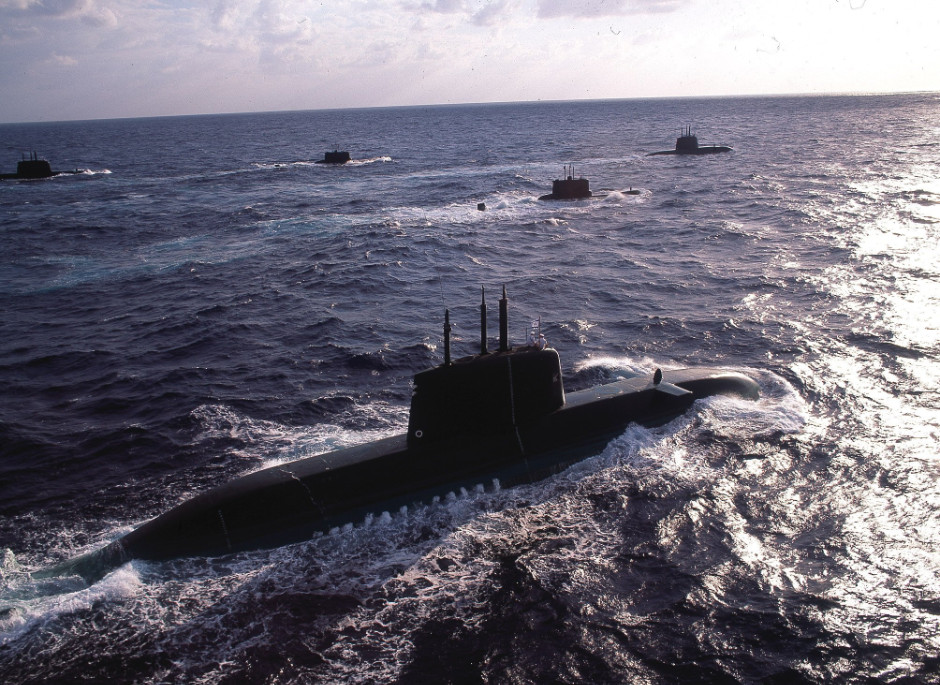
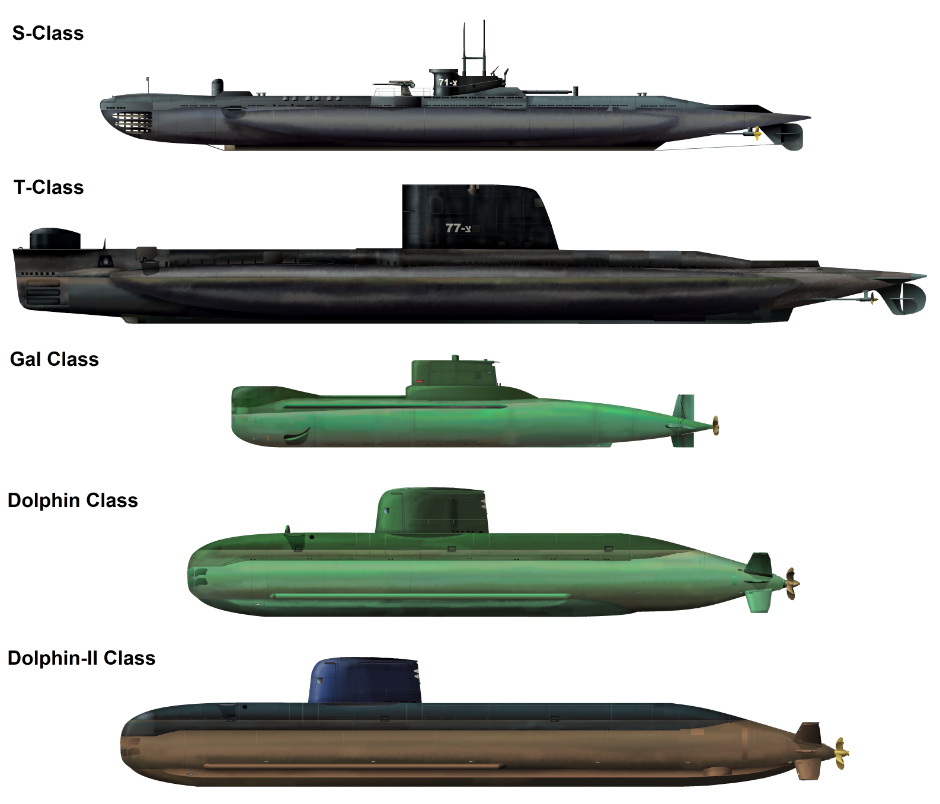
S-Class
Israel's first submarines were ex-Royal Navy S-Class submarines which entered service in 1960. The Israeli navy operated two boats, S-71 INS Tanin (ex-HMS Springer) and S-73 INS Rahav (ex-HMS Sanguine) until the late 1960s. Built in the final days of WW2, they had undergone a modest modernization after the war involving the fitting of a folding snort mast to allow charging of the batteries whilst the boat was submerged, and better sonar. All the same these boats were essentially WW2 era types largely obsolete even before they entered Israeli service.
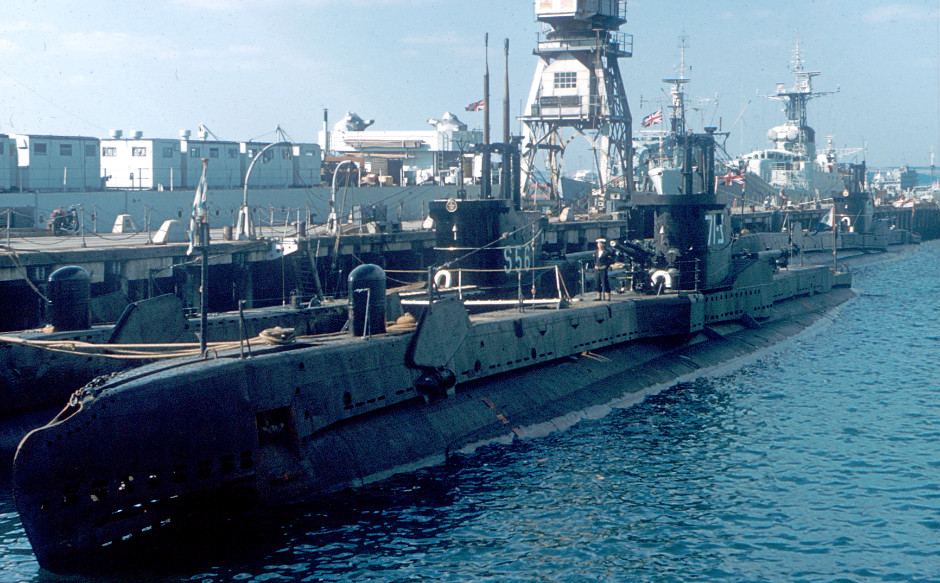
INS Tanin (S-71) in UK prior to delivery. The Sonar dome on the forward casing and 'bolt on' folding snort mast just aft the conning tower are clearly visible. Source: http://www.dolphin.org.il/
Specification
Displacement: 814-842 tons surfaced, 990 tons submerged
Length: 217 ft (66 m)
Beam: 23 ft 6 in (7.16 m)
Draught: 11 ft (3.4 m)
Speed: 14.75 kts surfaced, 8 kts submerged
Max depth: 350 ft (106m)
Complement: 49 officers and men (+9 passengers in 1967 war)
Armament: Six forward 21" (533 mm) torpedo tubes (12 Mk8 torpedoes). One QF-4 deck gun, twin AAA machine guns

CLICK for HIGH-RESOLUTION image
The ultimate book of Special Forces subs Covert Shores 2nd Edition is the ONLY world history of naval Special Forces, their missions and their specialist vehicles. SEALs, SBS, COMSUBIN, Sh-13, Spetsnaz, Kampfschwimmers, Commando Hubert, 4RR and many more.
Check it out on Amazon
Super-T Class
Within five years of the S-Class boats joining the flotilla the Navy was already searching for a more capable replacement. Three British T-Class submarines were selected. These were actually older hulls than the S-Class that they were replacing but they were of a larger and more capable class had had gone through a much more extensive upgrade after the war. This brought them up to roughly the same standard as average Royal Navy diesel boats of the time and was sometimes referred to as 'Super-Ts'. They bore no outward resemblance to their original fit, with completely new casing, bow, fin (sail) and aft casing. All external torpedo tubes had been removed to streamline the hull and make room for a large bow sonar dome. The gun had long-since been removed and the snort mast was fully integrated into the tall streamlined fin.
The three boats were INS Leviathan (S-75, ex-HMS Turpin), INS Dakar (S-77,ex-HMS Totem) and INS Dolphin (S-79, ex-HMS Truncheon) were purchased from 1966 and underwent extensive refits in UK before delivery (with Dolphin being refitted in Israel). They served until the late 1970s.
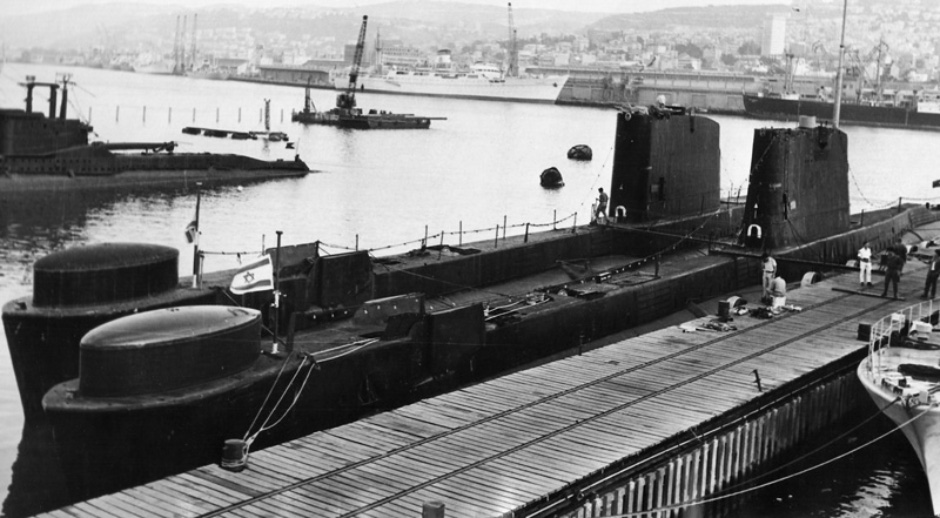
INS Dolphin (S-79) (right) and INS Leviathan tied up alongside in Haifa in 1971. The aft casing of a retired S-Class boat can be seen in the background. Source Uri Dotan Bochner, Wikipedia
Specification
Displacement: 1535 tons surfaced, 1740 tons submerged
Length: 87m
Beam: 8.75m
Draft: 5.28m
Speed: 17-18kts max submerged
Diving depth: 300ft
Complement: 67
Armament: six 21" (533mm) tubes torpedo tubes with 12 torpedoes

CLICK for HIGH-RESOLUTION image
1967 six-Day war
The first of the Super-Ts, INS Leviathan, was on her delivery cruise when the war broke out on 5th June 1967. She was already racing to Israel in the expectation of hostilities but arrived a day to late to take part. Only one of the older S-Class boats was serviceable and INS Tanin took an active part, deploying commandos to attack the Egyptian port at Alexandria, and also engaging an Egyptian frigate with torpedoes. The attack was thwarted and Tanin was subjected to depth charges. She escaped but was seriously damaged. Despite this, her captain took her back into Alexandria the next night in an attempt to rescue the commandos.
INS Dakar
On 9th January 1968 the second of the Super-Ts, INS Dakar, sunk on her delivery voyage without explanation. No one survived to tell the tale and so this has gone down in history as one of the great maritime mysteries. The exact circumstances are still open to debate but it seems most likely that it was some sort of accident. However, because it happened at a time of heightened tensions there was something of a cover-up, or at least a lack of communication, a number of theories soon emerged. Despite the fatal accident, the other two Super-Ts continued to give good service to the Israeli Navy. The hull was finally found in 1999 and there has since been an investigation but the cause remains a mystery. The Israeli Navy likes to re-use submarine names on later boats but there will forever only be one INS Dakar.
Gal Class
The Super-Ts were by no means as large as the fleet submarines being built for the major powers at the time (except perhaps the French) but they were considered too large for the sorts of inshore missions that the Israelis wanted to use their submarines for. This is when the Israeli way of doing things started to take on its own character and drive submarine development in a very different direction. Israel wanted a small coastal submarine with far fewer crew but still with a full complement of torpedoes. The traditional naval supplier to Israel were the British but they had squandered their world lead in 'midget submarine' design and were concentrating on larger submarines. Their other major historical arms supplier, France, had decided to impose an arms embargo and the US hadn't built a diesel attack submarine for ten years. The only submarines the US exported were second-hand diesel boats equivalent to the Super-Ts. The answer lay in an unlikely quarter: West Germany had recently started to rebuild its submarine construction capability which started out with small 'training submarines'. Now no-longer looking at operating submarines mid-Atlantic, these designs morphed into very small submarines for the Baltic and North Sea. Their main design at the time was the Type-206. A modified variant of this boat would be ideal for the Israeli Navy but there was a catch; the Germans had export restrictions and could not build the subs for Israel. So a cunning workaround was arranged through Israel's traditional submarine supplier, the British. The 'Type-540 Gal Class' submarines were to be built by Vickers in the UK. The fact that Britain was at the same time supplying arms to the Israel's enemies was not lost on anyone. The three submarines, INS Gal, INS Tanin and INS Rahav were delivered from 1976 with the last being decommissioned in 2002.
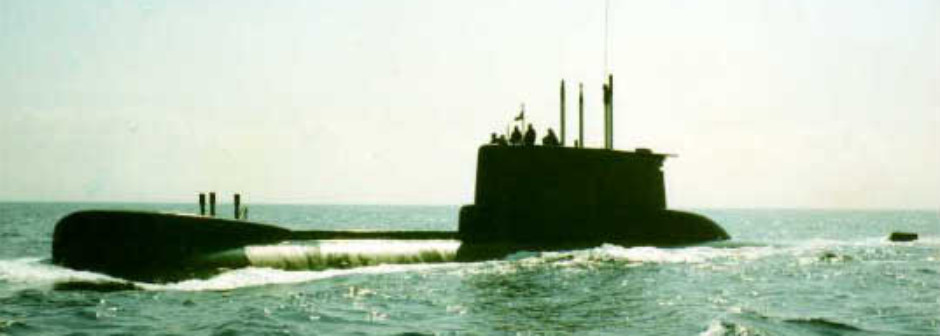
Gal Class submarine. Source: http://www.submarines.dotan.net/gal/
Specification
Displacement: 420 tonnes surfaced, 600 tonnes submerged.
Length: 45m (148ft)
Beam: 4.7m (15ft)
Draught: 3.7m (12ft)
Speed: 11kts surfaced, 17kts submerged.
Complement: 32
Armament: eight 21" (533mm) torpedo tubes with Sub-Harpoon anti-ship missiles and Mk-37 (NT 37E) torpedoes. SLAM anti-aircraft missile system once fitted (see below)
The use of US supplied Mk-37 torpedoes is noteworthy because they are much shorter than other types of 533mm torpedo. This doesn't allow more to be carried, but it would help save space. The Harpoon missiles however were added in the early 1980s and are full-size.

CLICK for HIGH-RESOLUTION image
Get The essential guide to World Submarines
This Covert Shores Recognition Guide Covers over 80 classes of submarines including all types currently in service with World Navies.Check it out on Amazon
SLAM - submarine surface to air missile system
One of the novel features of the GAL design was the British SLAM (Submarine Launched Airflight Missile) system which could be fitted into the sail. This consisted of a pedestal with an optical sensor and a cluster of six Blowpipe SAMs. The system was also slaved to the periscope. In order to fire the missiles the pedestal mast was raised above the water, typically with the submarine at periscope depth. The missiles were guided in flight with a crewman using a joystick to guide the missile to the target. The Blowpipe missile was a first-generation shoulder-launched weapon loosely equivalent to the Redeye and GRAIL systems (i.e. the generation before Stinger). The concept was that the submarine would use these missiles to down or deter slow moving anti-submarine helicopters, particularly ones using dipping sonar which would present relatively unchallenging targets for the system.
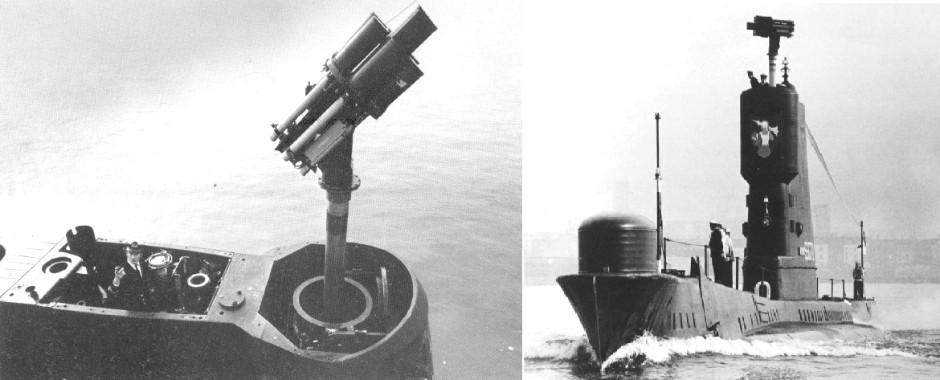
SLAM being tested on a British diesel submarine, HMS Aeneas in 1972
Although the GAL Class were fitted for the system, it never entered service; it was quickly obsolete and the capability was quietly removed without replacement.
Dolphin Class
Planning for the replacement of the Gal Class started in the mid 1980s but was put off as a low priority when Israel had to refocus on the new threat of Iraqi nuclear and chemical weapons. During the 1991 Gulf War which followed Israel was on the receiving end of upgraded Iraqi SCUD ballistic missiles. It transpired that German firms were partly responsible for supplying critical technologies to Iraq. For this an other economic reasons the German government decided to fund the Israeli replacement of the Gal Class. The new submarines would be far more advanced than the then-standard Type-209 submarines and were called the Dolphin Class.

Dolphin Class submarine. Note the more recent darker paint scheme with blue sail. The boats were originally painted green llke the older Gal Class. Greens and turquoise have been found to be extremely effective in the Mediterranean Source: Via here
Specification
Displacement: 1,640 tons surfaced, 1,900 tons submerged
Length: 57.3m (188 ft)
Beam: 6.8 m (22 ft)
Draught: 6.2 m (20 ft)
Speed: 20 kts submerged
Test depth: At least 350 m (1,150 ft)
Complement: 35 + 10 passengers
Armament: Six 21" (533mm) torpedo tubes and four 26" (650mm) torpedo tubes. Twenty-one rounds in total (see notes).
Three Dolphin Class submarines were acquired; INS Dolphin, INS Leviathan and INS Tekumah entering service from 1999. A degree of controversy surrounds the weapons fit as there larger diameter 650mm torpedo tubes are not needed for any standard Western weapon. Several suggestions have been put forward but the most persuasive is that the tubes are needed to launch Israeli developed Popeye cruise missiles. The US reportedly refused to sell Tomahawk cruise missiles, which would fit into the standard 533mm torpedo tubes, so Israel developed their own weapon based on the larger diameter Popeye air-launched missile. This has reportedly been test fired in the Indian Ocean where it demonstrated a range of 1,500km. Even more controversial is that it is consistently reported that these missiles can be equipped with nuclear warheads (Israel is an undeclared but widely accepted Nuclear power) giving the Dolphin Class a nuclear deterrence role. If they are used as nuclear deterrence then their usefulness as regular attack submarines is negated, it's one or the other. Other less exotic weapons carried are the Sub-Harpoon anti-ship missile and modern German made Seehecht torpedoes.

CLICK for HIGH-RESOLUTION image
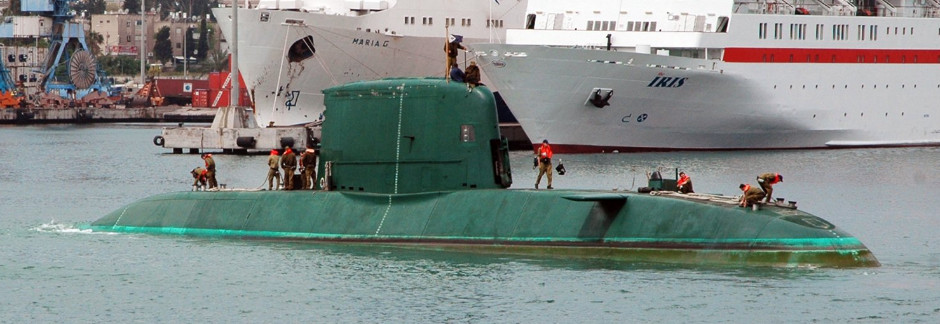
Dolphin-II Class
The Dolphin class were much larger and more advanced than other German submarines when they were built, but they lacked one characteristic which was already all the rage; Air Independent Propulsion (AIP). This describes any system which allows a submarine to run its diesel engines (used for recharging the batteries) without having to raise a snorkel up to the surface to supply fresh air for the engines. The benefits of this are obvious and much discussed. There are several approaches and the history of this technology is quiet interesting and full of surprises, but that is a different topic! By 2000s the latest diesel-electric submarines on the market all had AIP so it was natural for Israel to fit it to her submarines, especially if they are indeed tasked with nuclear deterrence.
Outwardly the Dolphin-II is simply a Dolphin Class boat with a large 'plug in' section added behind the sail to contain the AIP systems. Interestingly the submarine's size is therefore rapidly approaching that of the Super-Ts which were at a time deemed too large.
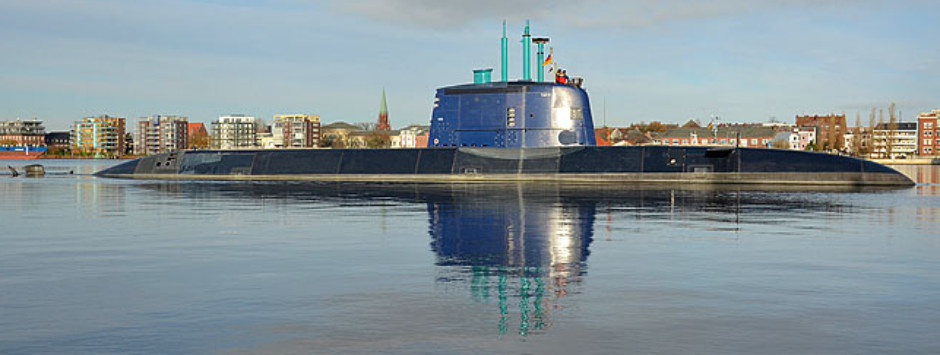
Dolphin Class submarine INS Tanin before delivery from Germany. The internet era has prevented high quality images of the boats leaking out. The circular hatch catching the light on the starboard (right) side of the sail is the diver lock-out. Source: http://www.geniusstrand.de/
Specification
Displacement: 2,050 tons surfaced, 2,400 tons submerged
Length: 68.8m
Beam: 6.8 m (22 ft)
Draught: 6.2 m (20 ft)
Speed: 25 kts submerged
Test depth: At least 350 m (1,150 ft)
Complement: 35 + 15 passengers
Armament: Six 21" (533mm) torpedo tubes and four 26" (650mm) torpedo tubes. Twenty-one rounds in total (see notes).
Three Dolphin-II boats have been ordered with the first, INS Tanin, arriving in Israel in September 2014. The second, INS Rahav is also expected to be delivered in 2014 and a third is expected in 2017. These are completey new builds rather than rebuilds of the original Dolphin class boats.

CLICK for HIGH-RESOLUTION image
Related Articles




 +
+ 



 Nuclear Missile submarines
Nuclear Missile submarines















 World survey of AIP submarines
World survey of AIP submarines

 Barbel Class - the last front-line diesel boats int the US Navy
Barbel Class - the last front-line diesel boats int the US Navy

 Iranian Fateh Class SSK
Iranian Fateh Class SSK

 HDS-500 Midget Submarine
HDS-500 Midget Submarine

 Maritalia GST-23+ Midget Submarine
Maritalia GST-23+ Midget Submarine


